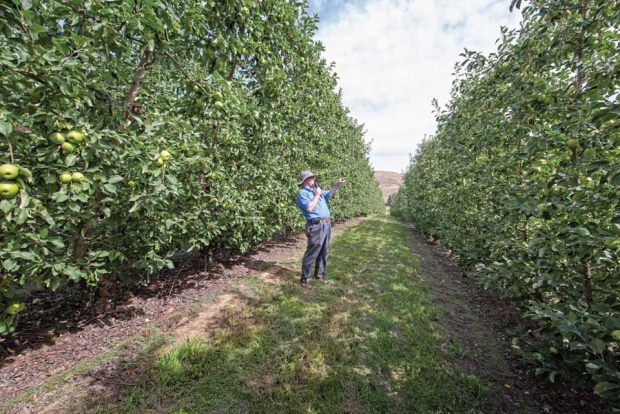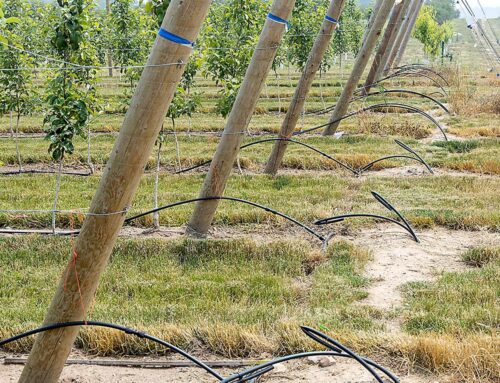
Jason Matson from Matson Fruit Company shows some of his Honeycrisp rows during the IFTA Washington tour on July 16, 2015. Matson says they were grafted in 2010 and spaced 5×16 with four leaders per stump in a V-trellis system about 12.5 to 13 feet tall. (TJ Mullinax/Good Fruit Grower)
There’s more than one way to plant a modern, highly productive orchard. While some growers like to plant the largest nursery trees they can find, others prefer the smallest.
Dale Goldy, assistant general manager with Stemilt Ag Services, based in Wenatchee, Washington, said he likes to plant large nursery trees — preferably knip trees — for his tall spindle plantings (Read “Planting materials” below).
The tall spindle, which is popular in Europe, is an easy system to teach workers because much of the tree’s development is done in the nursery before it’s handed off to the orchard.
It’s also easy to duplicate from one orchard to the next, which allows employees to be moved around without difficulty, and the system lends itself to the use of new technologies and potentially automated harvest.
“Once you have people who are trained, it lends itself to being a very efficient system,” he said. “It’s not very complicated. There are three or four rules you have to adhere to, to make it work.” (Read “Basic rules of Stemilt’s tall spindle”)
Goldy said the people factor — human capital — plays a significant role in the system’s success, and execution is 90 percent of good horticulture. “So, you can have the greatest horticulture, but if you can’t make it happen, then it’s not worth very much.”
Trellis first
Gala trees are planted 3 to 4 feet apart in the row and Honeycrisp 2.5 to 3 feet. Rows are 12 feet apart to accommodate platforms.
Jamie Jamison, regional manager for Stemilt Ag Services, came up with the idea of installing the trellis and irrigation system first and then planting the trees by hand, which has a number of advantages. “It’s one of those outside of the box kind of things because we’re doing it in reverse order,” Goldy said.
It’s resulted in less breakage of trees, particularly those on Geneva rootstocks where the graft union is weak, as well as lower costs for planting and for building the trellis. Trees can be clipped to the trellis as soon as they’re planted to avoid wind damage and are irrigated within 10 to 15 minutes of being planted.
It’s been said that any bend in the central leader can reduce growth by about 30 percent, so Goldy supports individual trees with bamboo stakes.
The goal is for trees to reach the top wire by no later than the end of the second leaf. He stops fertilizing as early in the second leaf as possible, in order to produce high quality fruit sooner, and hopes for a robust crop in the third leaf.
Tree training is done mainly in February and March — as soon as the sap flows and the branches become flexible enough to tie down — and is finished before the crews need to work on hand thinning or cherry harvest.
The goal is to maintain uniform light distribution from the top to the bottom of the tree to achieve consistent fruit color and maturity throughout, resulting in fruit with better storing and eating quality and enabling workers to pick a higher percentage of the fruit in one pass.
Angled system

Travis Allan, from Yakima Valley Orchards, shows a v-trellis system installed on a metal framework during the first day of the IFTA Washington tour on July 15, 2015. Allan said he uses heavy gauge steel, which costs more per acre, to help the system hold up to heavy crops and high winds. (TJ Mullinax/Good Fruit Grower)
Travis Allan, president of Yakima Valley Orchards, uses an angled system with trees 1.5 to 2 feet apart and 12 feet between rows to accommodate current equipment. His target canopy height is 11.5 to 12.5 feet. He’s switched to metal poles because of concerns about the availability and quality of wooden poles.
Unlike Goldy, he prefers to plant anything that is not a full-sized tree, whether bench grafts, sleeping eyes or rootstocks budded in place, with the trellis installed afterward.
“The full-size tree is my enemy,” said Allan, who believes it takes too much work to plant big trees and put the trellis together when a grower is planting a hundred acres at a time.
His goal is for the trees to grow 6 to 6.5 feet tall with four to six branches during the first year, and he expects them to be 9 to 9.5 feet tall by the second leaf. With Gala, he’s been able to harvest 40 to 45 bins per acre in the third leaf.
Jason Matson, farm general manager at Matson Fruit Company in Selah, Washington, uses a steep V-trellis system with trees 1.5 feet apart and 10 feet between rows. He prefers sleeping eyes to full-size nursery trees, and not just because they’re cheaper.
In order to have trees with the characteristics he wants, he would cut back nursery trees at planting to almost nothing anyway, he said.
Another advantage of sleeping eyes is the shorter lead time for selecting the variety.
The roots of a sleeping eye are more in balance with the top, he said, so they don’t suffer transplant shock. They stay vegetative longer and grow better, in his experience.
Honeycrisp
With Gala, Matson uses a formal limb positioning system with the goal of producing up to 100 bins per acre. However, with Honeycrisp, he’s gone through a progression to find the right system.
His first Honeycrisp planting 10 years ago was on a vertical system on a 4-by-10-foot spacing. He hoped the canopy would grow 11 feet tall, but the tops of the trees didn’t fill the space.
In 2008, he switched to a 4-by-9-foot vertical system, hoping they would reach 12.5 feet tall, but he had the same result.
In 2012, he planted Honeycrisp on a 1.5-by-10-foot V-trellis system, aiming for a tree height of 10 feet. “We could get there,” he said, “But the tops of the trees are just these spindly little branches. Honeycrisp grows really well for the first two years, and sometimes we can keep them going into the third, but we can’t get them any taller than 9 or 10 feet no matter how hard we try.
“It comes down to branching,” he added. “The first 2 to 2-1/2 years we get nice healthy branches, but after that they’re just little spiny things.”
In 2013, he planted the same system but developed two leaders per tree, for a total of 5,508 leaders per acre. Leader placement is formal, but side branching is not. He’s been stubbing back the limbs to try to keep them from setting fruit buds and to keep the trees growing upward.
“We’re really hoping we will finally get 100 percent canopy development, and at that point we should be able to get 100 bins per acre,” he said.
Obstacles
Asked about obstacles to success, Matson said there never seems to be enough time for tree training and everything else that needs to be done. Establishment costs, at $40,000 to $50,000 per acre, are also a challenge.
And it takes patience to develop a successful orchard. At first, his employees seemed to have difficulty understanding the formal training system.
“It was a hair-pulling experience,” he said. “But now we’ve gotten there, we don’t want to change because now our staff understands what to do. We’re so far down this path that it would be very difficult to emulate Stemilt. It’s just a cultural thing, and I feel good that our staff understands the goals of the system.”
Goldy warned that the “plant-in-place” systems (bench grafts, sleeping eyes and budding in place) may be less expensive than planting full-grown trees, but they only pencil out if the grower has the technical skill to bring them into production sooner.
“People look at them as a cheaper solution, but it generally delays their production over just buying a nursery-grown tree,” he said. “The cost of maintaining these ‘cheap trees’ in the orchard for additional years while they fill their space greatly outweighs the upfront cost of a good nursery tree.”
The panel discussion took place during the Washington State Tree Fruit Association’s Annual Meeting in December. •
– by Geraldine Warner
Planting material
Several different types of planting material can be used to establish an orchard.
Bench graft: This starts out as a rootstock, which is taken out of the nursery layer bed in November and bench grafted with scion wood between January and April. Bench grafts are delivered for planting after the last spring frost. Bench-graft trunks will be about 14 to 16 inches tall, with the top 4 inches being the scion wood. Rootstock choice must be made before they are dug, and the scion variety must be determined before the rootstocks are grafted. The short lead time gives growers more time to decide on their variety-rootstock combination, but bench grafts are the most sensitive to environmental and horticultural practices in the orchard.
Sleeping eye: This starts out as a rootstock planted in the nursery a year ahead of the delivery date. The rootstock is budded with the scion variety around August. At the end of the season, it is cut to the scion bud and dug up for delivery the following spring. The trunk will be about 5 to 6 inches long, with an extensive root system. Rootstock decisions must be made a year before planting, with the variety decision made several months later.
Standard nursery tree: This starts out the same way as a sleeping eye. The rootstock is planted in spring, budded in August, cut back, and then allowed to grow for one more year. The following November, the tree is dug up for dormant delivery in the spring. It needs to be ordered at least two years in advance of delivery.
Knip tree: This begins as a bench graft grown in the nursery the first year. The next spring, trees are cut back to desired height and the central leader established. It is dug that fall for delivery in late winter or early spring. Growth is better than with a standard tree because of a strong root system, thicker caliper trunk and increased branching. It needs to be ordered at least two years in advance of delivery.
Budding in place: Rootstocks are planted in the orchard in the spring and budded to the scion variety around August. The grower develops the trees.






Leave A Comment